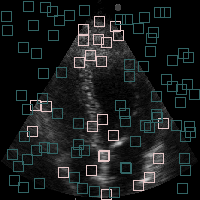Zaraban is a biomedical tools that provide high-level APIs for analyzing echocardiograms. This python package consists of various methods including:
- Seckle detection using machine learning
- Speckle Tracking Echocardiography (STE)
- Movement visualization and saving
- ...
Download and extract the file in the site-packages folder of Python. After downloading the package, you should install all packages in requirements.txt by the command below:
pip install -r requirements.txt
Here are some examples for reading, tracking and saving frames with Zaraban.
But before that it is necessary to import some modules as follows:
from zaraban import tools
from zaraban.STE import track
from zaraban.STE import speckle
frames = tools.read_frames(path, size=(200, 200), pattern="im ({}).bmp")
path: path of the parent folder of frames.
size (optional): desire output frame size. Default=(200, 200).
pattern (optional): filename pattern. If it is not determined, files will be read alphabetically.
In order to train the model for speckle detection, you first need to extract some patches and use their features as the train data.
UnSupervised:
points, patches, features = speckle.random_point_patch_feature(frames, kernel_radius, amount)
speckle_model = speckle.Speckle(method='unsupervised')
speckle_model.fit(speckle.flat(features))
Supervised:
points, patches, features, labels = speckle.train_test_feature_select(frames, kernel_radius, amount)
speckle_model = speckle.Speckle(method='supervised')
speckle_model.fit(speckle.flat(features), speckle.flat(labels))
*amount: number of points per each frame
Since features are a three-dimensioanl array, you might want to use features related to a specific frame as shown below:
test_labels = speckle_model.predict(features[:, :, 0])
Let’s separate speckle by a rectangle around it:
speckles_image = speckle.overlay_speckle_box(points[:, :, 0], test_labels, frames[0], kernel_width)
and then save the output image:
import cv2
cv2.imwrite('speckles_image.png', speckles_image)
The saved image would be like this:
There are two types of tracking method: Eulerian vs Lagrangian.
-
If you want to track some specific speckles (Lagrangian), use the code below:
markers = speckle.pick_point(frame, amount) (vectx, vecty) = track.track_points_sequential(frames, markers, WS=kernel_radius, SS=search_radius, model=speckle_model, show_message=True) plt.imshow(frames[0]) plt.plot(vectx, vecty)
*amount: number of points per each frame
-
If you want to detect speckles' motion between two consequent frames (Eulerian), use the following:
(vectx, vecty) = track.track_fixed_sequence(frames, WS=kernel_radius, SS=search_radius, model=speckle_model, show_message=True) vrgb = tools.convert2map(vectx, search_radius) tools.save_as_video('output.avi', vrgb, overlay=True, source=frames)
